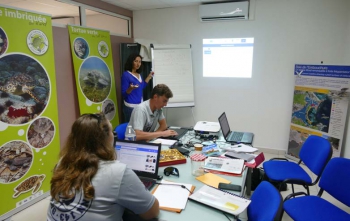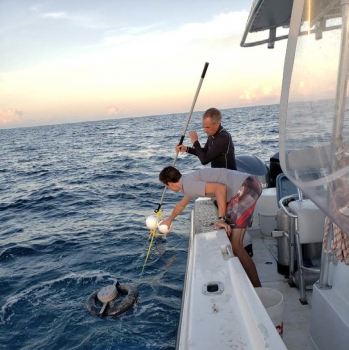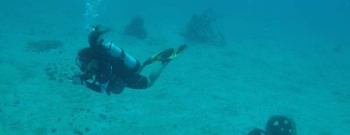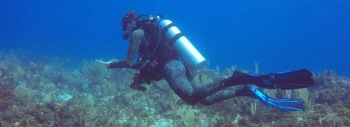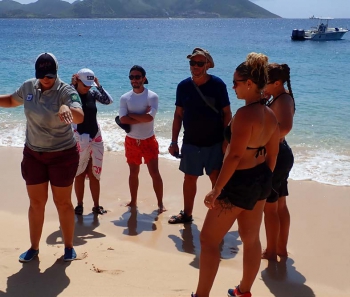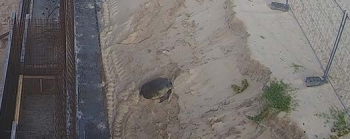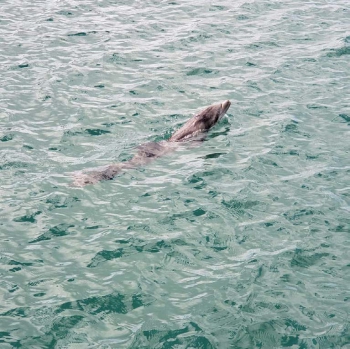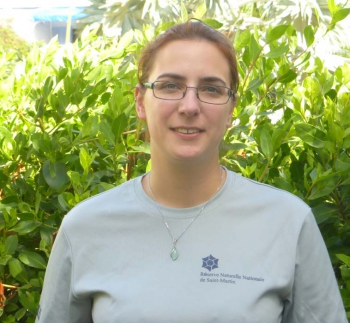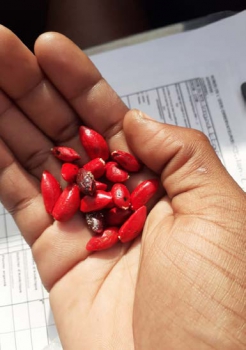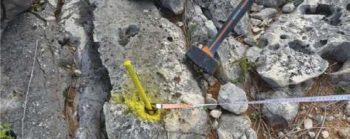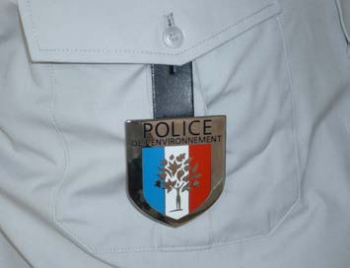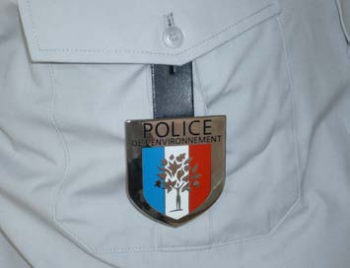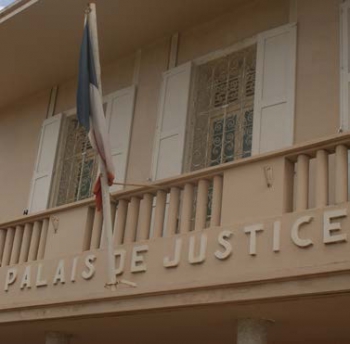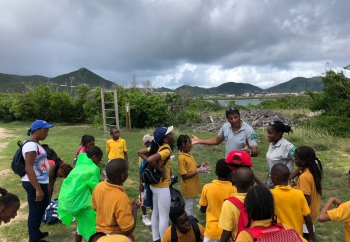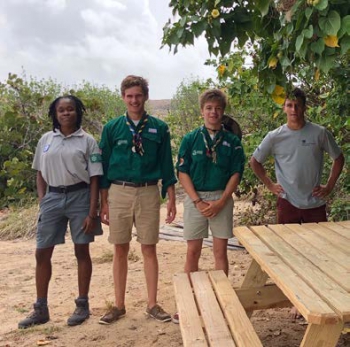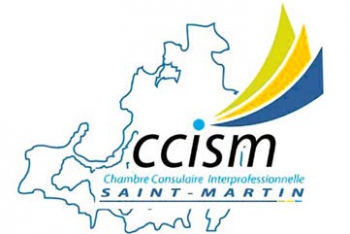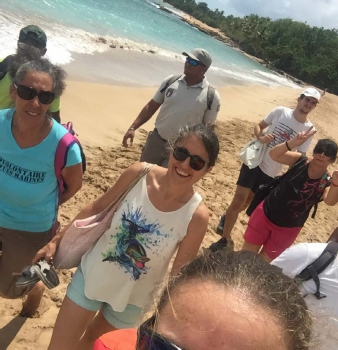As part of the European project, LIFE BIODIV’OM, the goal of Réserve Naturelle de Saint-Martin is to concentrate on the preservation of the Nassau grouper and giant grouper, two endangered species. Aude Berger, who holds a diploma in ocean sciences and techniques as well as a professional degree in environmental protection from the University Antilles- Guyana, was expressly recruited in January 2019 by the Réserve to head this project for a period of five years. Working with Julien Chalifour, scientific director of the Réserve, she was trained in the beginning of the year to use the TESSA tools to measure various impacts inflicted on the natural milieu and the consequences on the services that a healthy ecosystem should provide. More recently, on June 24-28, the two scientists took part in a training session led by two professors from the Centre for Resource Management and Environmental Studies (CERMES) at the University of Barbados, and learned all about the SocMon method for «socio-monitoring.» Initially created for coastal marine ecosystems, this method was adapted to the two grouper species targeted by the LIFE program, in order to understand the challenges, including economic ramifications, as the goal is population growth for these two kinds of fish. For that to happen, they will have to study the history of these fish, as well as understand their use, to be able to identify the roadblocks in creating a sustainable management program. Then on July 10-12, a third professor from the CERMES gave them the necessary tools for a field-based inquiry comprising a questionnaire to help facilitate the challenges related to these grouper species for the population of Saint Martin.
Journal-36
Journal-36
To promote the conservation of the coral reefs and related species
It is interesting to note that 90% of the fish larvae, including the grouper, dies during its dispersion in ocean currents, while the recuperation and raising of post-larva fish is an efficient method to increase the number of individuals. But several questions remain. How to catch these tiny little fish? When? Where exactly? How many? And how to recognize them? To help find the answers to these questions, the company, Écocéans, trained the team at the Réserve Naturelle in larval collection, as part of the LIFE program. On October 3, and for a few days after, luminous sampling tubes were deployed in the ocean to collect larvae carried by the currents. The larvae are then moved to a marine milieu where they transform into post-larvae, ready to colonize the coastal waters. This operation takes place at night, as these miniscule animals are attracted by the light, and will be repeated regularly over a period of two years to determine the best moment to recover the grouper larvae. Once this technique has been mastered, the larvae will be raised in an aquarium until they are large enough to return to their natural milieu and have a better chance of survival.
An intern at the Réserve Naturelle from August 15-30, Colette Buisson was a student at the Institut Intechmer of Cherbourg (CNAM), where for three years she trained in engineering techniques for marine environments, and where she successful completed her program. While at the Réserve, she participated in the implantation of the second BioHab2 artificial habitat, not far from Anse Marcel within the perimeter of the Réserve Naturelle, and to study the colonization of these under-water habitats. Encouraged by Julien Chalifour, the young woman decided to enroll for a master’s degree at the University of Corsica.
La Réserve Naturelle is seeking volunteers to answer a questionnaire designed to determine the presence of certain species of fish in Saint Martin. If you would like to participate, please contact: reservenat.aude@yahoo.com, 06 90 47 02 13.
To promote the conservation of seagrass beds and related marine plant species
Since 2007, the Réserve Naturelle has done an annual scientific study of the reefs and plant beds. This took place this year on September 9-12, with the support of a staff member from the Réserve Guadeloupéenne de Petite-Terre. He came to help the staff in Saint Martin document the evolution and state of these coral and sea plant communities, at stations inside and outside of the Réserve. As usual, this kind of collaboration will see the staff from Saint Martin similarly lend a hand in Saint Barth and Petite-Terre. This year, this ongoing study was augmented by a study of groupers, as part of the LIFE program, at four of the eight sites visited. These sites will also be the object of a bi-annual study throughout the LIFE program, until 2023
To promote the conservation of the sea turtle population
The volunteers of the sea turtle network regularly accomplish their solitary mission, which consists of finding the tracks of turtles that come to lay eggs on the beaches, and noting signs of their nesting. In order to meet them and introduce them to the activities of the Réserve, as well as help them improve their finding of the tracks, Aude Berger from the Réserve’s scientific department, invited the volunteers to Tintamare, on the beach in Bay Blanche and the lagoon. Twice a week, in August and September, one or two of these volunteers took part and appreciated this special experience, in a great natural setting in the presence of our scientific experts.
Other than the fact that buildings along the edge of the beach stops the development of vegetation to help prevent erosion along the shore, which leads to smaller beaches, construction also represents an obstacle for sea turtles to lay their eggs. On September 15, on a contruction site for a wall between a villa and the beach in Baie Rouge, workers rescued a turtle that had fallen into a deep trench dug for the foundation of the wall. Surveillance cameras caught the event on video and one can see the trapped turtle unable to get out of the trench on its own. Then the video shows the men helping extricate it—with diffuculty— and send it back to the beach. The Réserve Naturelle took advantage of this mishap to point out that sea turtles, as well as their essential habitats essentiels (zones for feeding and reproduction) are protected on a national basis, with the goal of preserving these populations threatened by mankind. These species and their habitats are part of our common heritage and play a role in the economic activity of our island.
To maintain or improve local conditions for marine mammal populations
On August 2, thanks to notification from the staff at the Marina Fort Louis and some boaters, the Réserve Naturelle tried to help a young dolphin in distress, injured on its snout and disoriented. Already sighted in the bay at Grand-Case, in a thin, weakened state, this little marine mammal was not yet weaned and died during an examination by veterinarian Dr. Michel Vély. The animal was treated according to the protocol for “marine mammals in distress” established by a national network to which the Réserve belongs. This small animal was kept for an autopsy, the results of which will be used for training purposes at the Agoa sanctuary
To maintain or improve local conditions for nesting bird populations
An intern at the Réserve Naturelle from February 18 through August 16, 2019, Camille Sanchez has since earned her master’s degree at the University Paul Sabatier in Toulouse. She contributed to the collection of data on shorebirds that visit the salt ponds in Saint Martin and entered the results on the eBird database, which includes all information collected since 2011 as part of the shorebird project. In the same spirit as the UNESCO MAB (Man and the Biosphere) program, which looks at the interactions between human activities and ecological systems with an eye toward sustainable management of natural resources, she completed a field-based perception survey with residents and tourists. The idea was to evaluate their knowledge on the existence of the ponds, the shorebird populations that visit them, and the management of these spaces and species. After her successful internship, Camille is currently looking for a job or might prolong her days at the university and begin a thesis.
To maintain or improve the ecological health of the salt ponds
The Réserve Naturelle received permission from the Collectivité to establish a nursery for mangroves on a tract of land temporarily made available to the Réserve by the Conservatoire du Littoral, close to the Orient Salt Pond. Funded by a grant from the Rotary Club, the goal is to replant 100,000 mangrove shoots in the salt ponds where the vegetation was decimated by hurricane Irma. The staff has been gathering seeds, pods, and seedlings in the field, and been growing them day-by-day in their facility in Anse Marcel. The shoots are placed in biodegradable pots made of sugar cane fiber that will be placed in the silt where the mangroves will develop. A wood structure will be built to provide shade for the shoots, before all of the seedlings are moved to the nursery. The Saint Martin Rotary Club financed 50% of the project, whose total cost is estimated at 48,500€. Delma Maduro, regional district governor for Rotary International, paid a visit to the nursery site on October 21, accompanied by members of the local club, and expressed enthusiasm for the project after listening to an introduction provided by the staff. Signage posted at the site has made the project official, in keeping with the methodology of the IUCN (International Union For Conservation Of Nature).
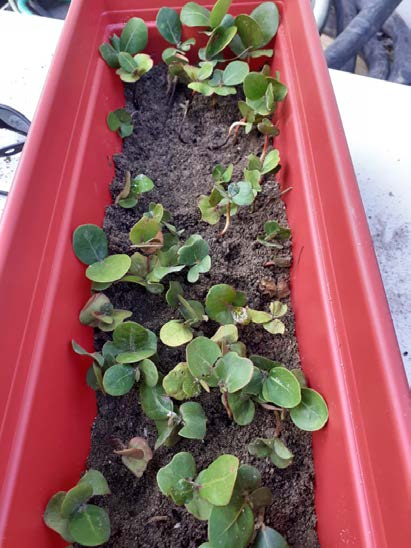
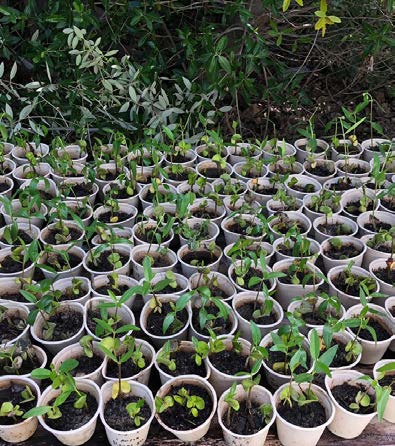
To promote the conservation of drought-resistant vegetation
The conservation of xenophile vegetation is one of the long-term goals of the management plan for the Réserve Naturelle. In this framework, the scientific department created an identification program for the flora on the islets of Caye Verte, Petite Clé, Pinel, and Tintamare. Financed by the French Agency for Biodiversity (AFB), this operation took place on July 15-19 and again on August 5-8, 2019, with the participation of Jonathan Migeot, PhD in tropical botany affiliated with ImpactMer in Martinique, as well as Karl Questel and Jonas Hochart from the Territorial Environmental Agency in Saint Barth. The four islets were investigated and special areas were defined and marked, and within each area the number and size of the plants were listed by species. This project will allow for the reconstitution of the flora on these islets over time. These missions resulted in technical notes, and a more detailed report will be forthcoming early next year, including recommendations for the convalescence of these impacted areas. As of now, we know that important differences exist in the number and types of species on each of the four sites, but also that the presence of goats and green iguanas has a major negative impact on the vegetation by limiting the reproduction of various species, most notably certain trees. Also, based on an itinerary of the flora done in 2016 by Caroline Fleury and Karl Questel, it will be possible to evaluate the consequences of hurricane Irma on the vegetal species in the Réserve.
Keeping an eye on the regulations and the level of human activities compatible with the goals of La Réserve
The staff at the Réserve Naturelle met with Stéphan Basso, the new commandant at the gendarmerie, who arrived on the island on August 1, replacing Sébastien Manzoni. The brigade chief voiced his interest in the various missions assigned to the rangers and assured the Réserve that it can count on the support of the gendarmerie, especially in the identification of scofflaws. Basso also invited the Réserve to be present when the next group of mobile gendarmes arrives on November 6, and to make a 30-minute presentation at that time, to best inform the new arrivals about the challenges encountered at the sites that are officially part of the Réserve Naturelle de Saint-Martin.
Since November 23, 2019, the Réserve Naturelle de Saint-Martin has been attending police meetings at the prefecture once a month, at the request of the prefect Sylvie Feucher. The police activity report for the Réserve is presented at these meetings. To date, since the beginning of the year, the Réserve police have accomplished 60 controls at sea that were in compliance and eight that were not, as well as 237 terrestrial controls in compliance and 17 that were not. For the most part, the infractions to regulations are minor, such as anchoring in a sea plant bed, use of a quad, dogs on the loose, or kite surfing at Galion.
La Réserve Naturelle was a plaintiff in a civil suit concerning illegal fishing, with Franck Roncuzzi, director of the technical department of the nature police representing the Réserve as its legal entitity. The case dates back to May 14, 2019, when a patrol from the gendarmerie found a fisherman on the beach in Grandes Cayes, right in the middle of the Réserve Naturelle. Inside the fisherman’s car, they seized two lobsters, a slipper lobster, two fish, and an underwater spear gun. Judged for maritime fishing in a prohibited zone and leisure fishing without marking his presence by a buoy, two infractions worth fines up to 9000 and 1500 euros respectively, the fisherman was condemned to pay 500 and 250 in fines, as well as 2500 euros in damages and interest to the Réserve naturelle.
Ensuring environmental communication, awareness, and education
Environmental awareness activities and education are among the priorities of the management plan for the Réserve Naturelle, which has been intensifying its pedagogical involvement in island schools since they recruited Vincent Oliva, the pedagogical program director for the Réserve in charge of environmental education. Cretaed by the Réserve, the pedagogical program «Let’s Project Nature Together” fits perfectly within the objectives of the educational efforts for sustainable development as defined by the Minister of Education, and instituted at schools in the Northern Islands. Vincent Oliva and Aude Berger met with Stéphanie Brouwers, education delegate for sustainable development for the school board, to let her know they are willing to visit the schools, especially Aude Berger on the subject of the LIFE project for the preservation of the Nassau grouper and the giant grouper. The school board has approved the project «Let’s Protect Nature Together,” as presented to school directors on October 15, in the presence of the Réserve Naturelle, which presented its own ideas for the project. Teachers have a choice as to which themes they want to develop in their classrooms, from biodiversity, to fauna, flora, marine ecosystems, natural heritage, and the preservation of the two grouper species. Field interventions are planned, on land and at sea. Concrete activities, for example related with the mangrove nursery, will be implemented. Agreements have already been signed with the Ecole Clair Saint-Maximin (with a CM1 and CM2 class who run their own educative marine site at Galion), the French Quarter middle school, Soualiga middle school, Robert Weinum high school, and the Northern Islands professional high school. Two private schools, Lamartine and Happy School, have also signed agreements, and additional signatures are expected. “Our goal is to intervene in every school on the island,” says Vincent. Teachers.
For additional information, please contact Vincent Oliva via email: reservenat.vincent@yahoo.com
In July and August, the rangers of the Réserve Naturelle, with the help of three scouts, completed the post-Irma cleanup of the islets of Tintamare, Caye Verte, and Pinel, the Froussards path, and the salt ponds. These scouts, from the Saint-Georges du Mans parish, were in Saint Martin on July 8-26, as part of a companion scouts program on a humanitarian trip from metropolitan France. Aged 18 to 19 years old, Louis Bourdin, Camille de Labbey, and Simon Avon filled 126 large garbage bags with trash and participated in the removal of heavy debris. On July 25, they had 14 young helpers who were in a trash management training program.
Understanding and continual study of the natural heritage
On July 30, 2019, Julien Chalifour participated in a technical atelier organized by the CCISM (inter-professional consular chamber) in Saint Martin, as part of the European «Forward» program. The goal of this project, launched in February 2019 with a budget of 1.3 M€, is to identify the leaders in research and innovation for the nine overseas regions of the European Union, and to facilitate their work and their exchanges. In Saint Martin, the idea is to create synergies between various economic needs on the island in order to stimulate local initiatives in such areas as digital systems, services, and heritage. The Réserve contributes to this project by sharing its knowledge and expertise in the domain of protecting the living natural heritage of the island.
Reinforcing local and regional commitment to the Réserve
At the request of the National Forestry Office (ONF), the Réserve Naturelle de Saint-Martin led a training session for the other members of the sea turtle network in Guadeloupe. The training took place during a full day at the Maison de la Mangrove in Les Abymes, followed by a half-day field trip on the Cluny beach in Sainte-Rose. Those participating in the training were familiarized with the existing pedagogical tools—posters, signage, lifesize cutouts, games—and with the most efficient techniques and activities.

